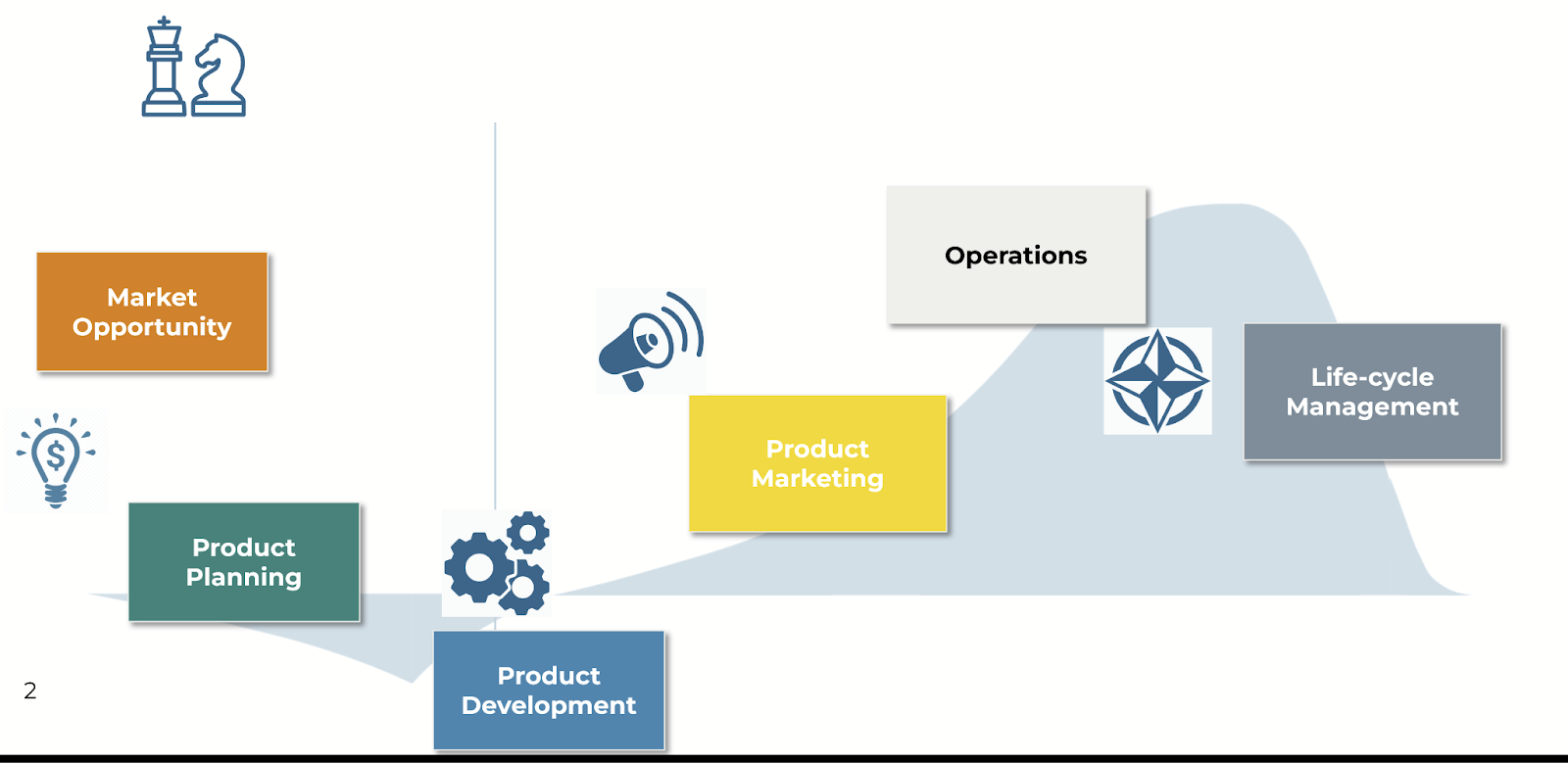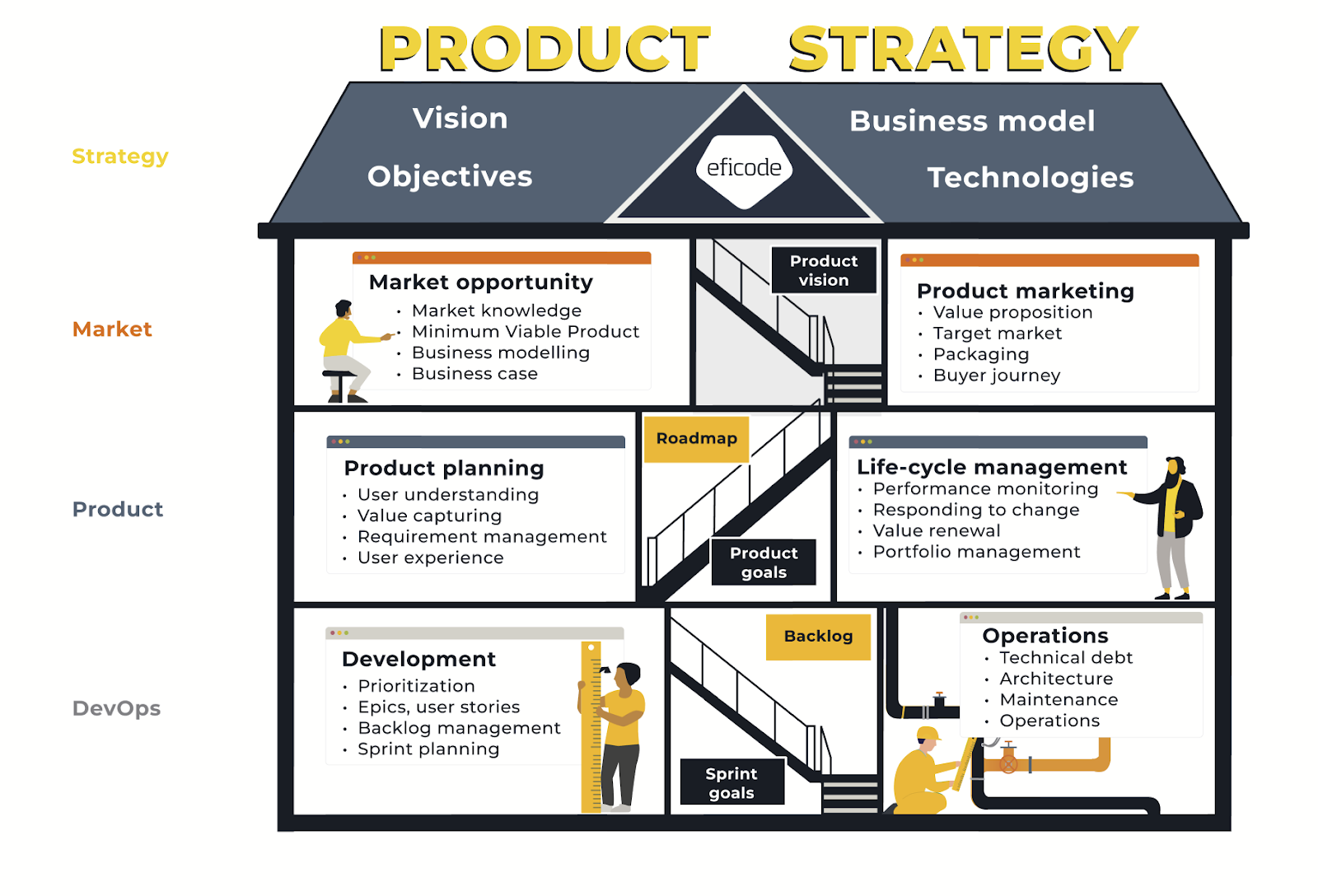Our house of product management model, which has helped thousands of product managers, has been renovated to better serve modern product leaders.
What is product management?
The goal of product management is to maximize the benefits and value your product or product portfolio generates throughout its lifecycle.
The focus in the early stages of product management is to establish adopter needs and accelerate adoption. For organizations that don’t yet know what their product needs, the focus should be on speedy experimentation.
Products in the later stages of their lifecycle need a different approach. Organizations may want to maximize the value they generate while minimizing effort. They may also need to plan an upgrade path to newer, more desirable products.

The reference model, the house of product management, helps product managers remember all the things that have to be done to ensure success. As products move through the lifecycle, the importance of different rooms in the house changes. The model can be used to evaluate what the product manager needs to learn.
Product managers and product owners
The title “product owner” is an Agile role that stems from the Scrum framework, prioritizing and defining the value of applications. A product manager has a wider responsibility covering all aspects of success. Often, they take on a product owner’s role in the development team as well, but sometimes these different roles are filled by two people as opposed to one, especially in the case of large and complex products where one person would be stretched to handle markets, customers, and technical details.
If the roles are separated in this way, the reference model can be used to clarify responsibilities and decision-making. The relationship between the product manager and owner is not a hierarchical one but more collaborative. It is advised that teams and organizations define product management roles and responsibilities based on their own circumstances.
Often the product manager takes on a more strategic role, managing the idea funnel and roadmap and actively engaging with a wide array of customers and market research. The product owner, on the other hand, looks at the near future backlog and technical details and engages more with the development team.
The new reference model expands on the house
We updated the reference model because it focused heavily on strategic product management, neglecting collaboration with the development team altogether. The organizational model was siloed and did not provide support for improving collaboration between product managers and owners.
The renewed version provides a better foundation for various situations. The product owner now understands the multifaceted responsibilities of the product manager, and the product manager, in turn, better appreciates the importance of working with the team. Product leaders can agree on specific responsibilities, such as managing the roadmap and backlog. Additionally, the “public” parts of the organizational model are clearly separated.

The new house of product management
There have been two significant changes in the house model. A new ground floor and a renovated “public space” (the staircase).
New ground floor
The new ground floor of the house includes two rooms, and the product development room falls under the responsibility of the product owner. It encompasses backlog management, prioritization, and definitions of work items. The operations room is more within the scope of the development team and includes technical debt management, monitoring product performance in production, deployments and releases, and customer support.
The two rooms on the ground floor are not exclusively under the control of the product manager. However, they are still important because the product manager needs to be interested and understand the amount of technical debt, even though they are not directly responsible for it.
By adding these rooms to the model, we hope to make it clear to product managers that even technical aspects of production are important to understand. Development is a continuous balance between technical quality and the creation of new features.
The staircase (public space)
In the house model's staircase, there are now clearly defined artifacts that should be widely publicized and understood throughout the entire organization:
- Roadmap
- Backlog
- Product vision
- Product goals
- Sprint goals
Every product organization needs to look at the state of these artifacts and evaluate them. Are they clear enough? Are they up to date? Are they well-known, understood, and in use? Issues with these artifacts are quite often the root cause of efficiency problems in development.
The goal hierarchy, from the product vision through product goals to sprint goals, is an important part of modern product development and management. A skilled product manager invests time and energy into actively managing these goals. When done effectively, it brings structure and discipline to the work, aiding in making the right decisions regarding plans, prioritization, and design at all levels of development.
The vision, roadmap, and backlog, on the other hand, are the most crucial artifacts in product management. They encapsulate the plan—what needs to be done, for whom, why, and in what order. Sufficient time must be allocated to managing the roadmap and backlog. Product leaders should set regular meetings with stakeholders for an overview of these critical development planning artifacts.
How to use the model
The model can be utilized in various ways:
- Defining the responsibilities of the product manager and owner.
- Assessing and expanding your own expertise in different areas of product management and identifying additional learning needs.
- Evaluating the state and visibility of the product goal hierarchy and understanding how well various components are known within the development team.
- Assessing the status and quality of management practices of the roadmap and backlog.
- Identifying areas of product management where things are in good shape and where challenges exist.
By doing the above, the house model can be employed to evaluate and enhance the overall effectiveness and success of product management.
Bring up these points collectively and consider what should be improved. There are several options, for example, training, mentoring, self-study, and coaching, and we can also help. We’ve been developing product management in Finland for over 15 years, so don't hesitate to ask for assistance.
Published: Jan 31, 2024


.png?width=200&name=Software%20Development%20Guide%20email%20cover%20(large).png)